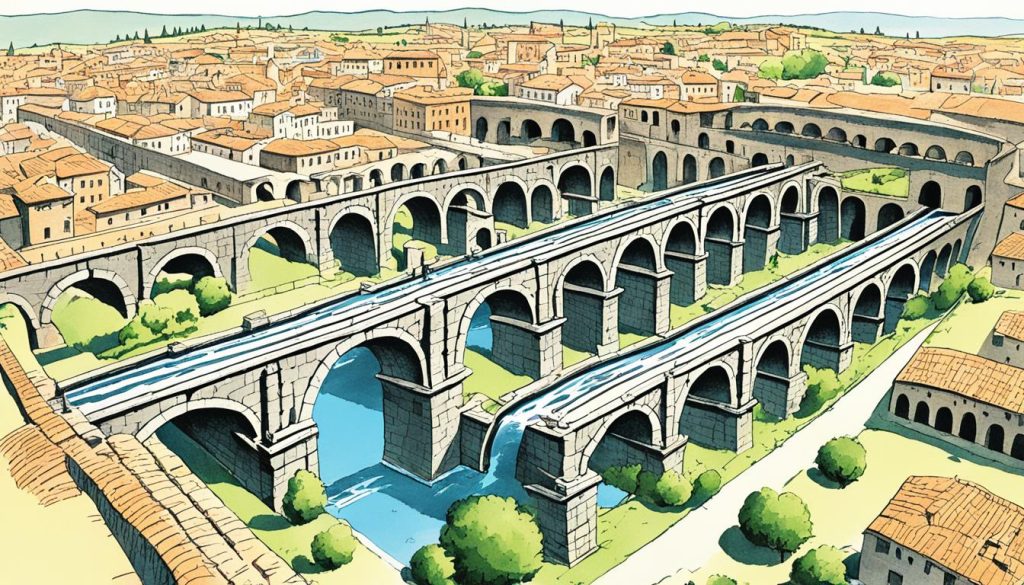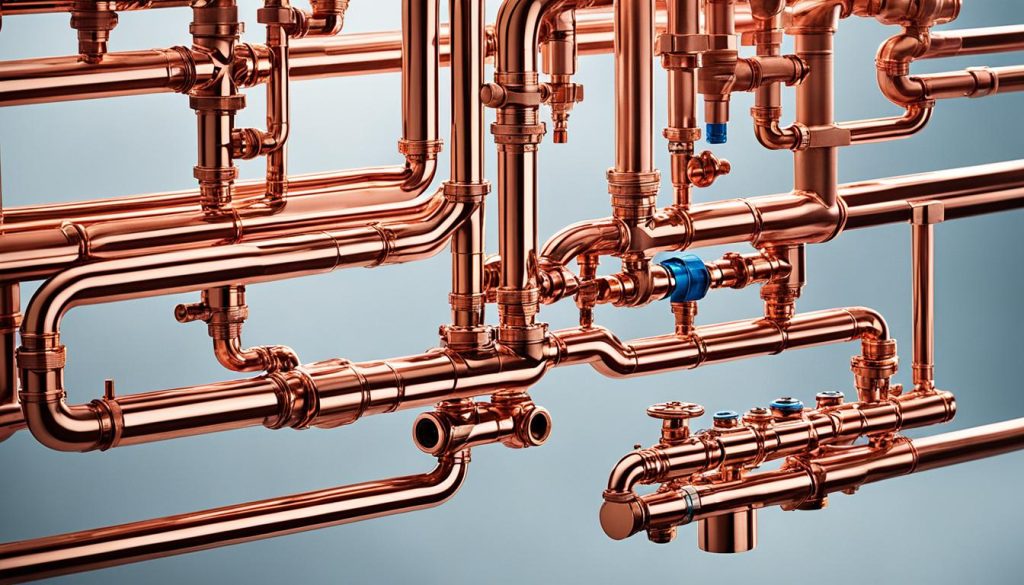Who Created Plumbing? Historical Innovators Revealed
Did you know that the origins of plumbing can be traced back over 6,000 years? It’s a remarkable journey that has shaped the way we live today. In this article, I will take you on a fascinating trip through time, exploring the inventors and advancements that have made plumbing an essential part of our everyday lives.
Key Takeaways:
- The history of plumbing dates back over 6,000 years.
- Various civilizations, including the ancient Egyptians and Romans, made significant contributions to plumbing systems.
- Important milestones in plumbing history include the invention of the flushing device and the establishment of underground sewers.
- Indoor plumbing evolved over time, with innovations like the Regency shower and flush toilets.
- Inventors such as William Elvis Sloan and Thomas Crapper played a crucial role in shaping indoor plumbing.
Early Examples of Plumbing Systems
Plumbing systems have been an integral part of human civilization for centuries. In this section, we explore some early examples of ancient plumbing systems and the remarkable advancements made by civilizations throughout history.
Indus River Valley – 4000 B.C.
The ancient Indus River valley civilization, located in present-day India, was home to an advanced plumbing system as early as 4000 B.C. Copper pipes were used in the palaces of this civilization, showcasing their innovative approach to water management.
Egypt – 2500 B.C.
Egyptians were quick to adopt plumbing systems, with evidence dating back to around 2500 B.C. Copper pipes were extensively used in irrigation, sewage systems, and even in the creation of sophisticated bathrooms within the pyramids. This demonstrates the exceptional engineering abilities of the ancient Egyptians.
Island of Crete – 1000 B.C.
The island of Crete, in ancient Greece, had plumbing systems that date back to 1000 B.C. These systems included bathtubs and indoor bathrooms equipped with flushing devices, highlighting the island’s commitment to cleanliness and sanitation.
Ancient Romans
The ancient Romans are renowned for their remarkable engineering feats, and their plumbing systems were no exception. They developed sophisticated systems that included public and private baths, water pipes, and underground sewers, showcasing their advanced understanding of hydraulics and sanitation.
These early plumbing systems laid the foundation for the advancements that followed, contributing to the development of modern plumbing as we know it today.
Important Milestones in Plumbing History
The history of plumbing is marked by significant milestones that have shaped the development of plumbing systems and regulations. From the invention of the flushing device to the establishment of underground sewers and the implementation of public health acts, each milestone has contributed to the advancement of plumbing technology and the improvement of public sanitation.
Flushing Device: Sir John Harrington – 1596
In 1596, Sir John Harrington invented the first recorded flushing device, a precursor to the modern flush toilet. This invention revolutionized sanitation practices and paved the way for the development of more advanced plumbing systems.
Cast-Iron Plumbing Line: King Louis XIV – 1664
King Louis XIV of France played a significant role in plumbing history when he ordered the creation of a cast-iron plumbing line in 1664. This plumbing line was designed to bring water to his extravagant castle, setting a new standard for plumbing technology at the time.
Underground Sewer: United States – 1728
To address the issue of open sewers and improve public hygiene, the United States installed its first underground sewer system in 1728. This milestone marked a significant advancement in sanitation infrastructure and laid the foundation for modern sewer systems.
Public Health Awareness Act: UK – 1848
In 1848, the UK introduced the National Public Health Awareness Act, a legislation aimed at promoting public health and ensuring proper plumbing systems. The act played a crucial role in raising awareness about the importance of sanitation and establishing guidelines for plumbing installations.
Accessible Water Heaters: 1870s
In the 1870s, water heaters became more accessible to the general population. This innovation allowed households to have a reliable source of heated water, further enhancing personal hygiene practices and improving overall comfort.
Standardization of Plumbing Codes: United States – 1930s and 1940s
Dr. Roy B. Hunter played a key role in the standardization of plumbing codes in the United States during the 1930s and 1940s. These standardized codes ensured the safety and efficiency of plumbing systems, providing guidelines for installation, maintenance, and repairs.
| Milestone | Year |
|---|---|
| Flushing Device | 1596 |
| Cast-Iron Plumbing Line | 1664 |
| Underground Sewer | 1728 |
| Public Health Awareness Act | 1848 |
| Accessible Water Heaters | 1870s |
| Standardization of Plumbing Codes | 1930s and 1940s |
The Evolution of Indoor Plumbing
Indoor plumbing has come a long way since its early developments in the early 1800s. Innovations during this time period paved the way for the convenience and comfort we enjoy today.
One notable development was the introduction of the Regency shower in 1810. This shower system brought pressurized water for bathing, making it a significant leap forward in indoor plumbing technology.
In 1829, the Tremont Hotel in Boston became the first establishment to offer indoor plumbing for its guests. This groundbreaking achievement set the stage for the widespread adoption of indoor plumbing in hotels and other public spaces.
The White House joined the indoor plumbing revolution in 1833, introducing indoor plumbing on the first floor. This marked a significant milestone, demonstrating the growing recognition of the importance of modern plumbing systems.
While flush toilets as we know them today were not yet invented, the concept can be traced back to Sir John Harington in 1596. His innovative design laid the foundation for future advancements in toilet technology.
During the 19th and 20th centuries, indoor toilets gradually became more prevalent in homes. What was once considered a luxury item eventually became a standard fixture in households worldwide, transforming the way we live and improving sanitation.
The Evolution of Indoor Plumbing Timeline
| Year | Development |
|---|---|
| 1810 | Introduction of the Regency shower |
| 1829 | Tremont Hotel in Boston offers indoor plumbing for guests |
| 1833 | White House introduces indoor plumbing on the first floor |
| 1596 | Sir John Harington invents the precursor to flush toilets |
| 19th-20th centuries | Widespread adoption of indoor toilets in homes |
Through continuous innovation and advancements in indoor plumbing, we have come a long way from the early developments. Today, indoor plumbing is an essential part of our daily lives, providing convenience, comfort, and improved sanitation.
The Inventors Behind Indoor Plumbing
The invention of indoor plumbing is the result of contributions from various inventors and innovators. While it cannot be attributed to a single individual, several notable figures played significant roles in its development.
In 1906, William Elvis Sloan introduced a groundbreaking invention known as the Flushometer. This device revolutionized the flushing mechanism, enhancing the efficiency and effectiveness of toilets.
Another key contributor to indoor plumbing was Alexander Cumming, a Scottish mechanic who invented the S trap in 1775. This curved pipe, still used in modern toilets, prevents sewer gases from entering buildings while allowing waste to flow smoothly.
Although often erroneously credited as the inventor of the flushing toilet, Thomas Crapper made significant contributions to plumbing. He refined and popularized the valve-and-siphon design, contributing to the overall advancement of indoor plumbing.
These individuals, along with many others, were instrumental in shaping the indoor plumbing systems we rely on today. Their ingenuity and innovations have transformed the way we utilize and appreciate this essential aspect of our daily lives.
Plumbing Inventions and Innovations
Copper plumbing has long been a popular choice for residential plumbing systems. In fact, its use can be traced back to as early as 4000 B.C. in the Indus River valley. The durability and corrosion resistance of copper pipes make them an excellent option for delivering clean water to our homes.
The invention of faucets has revolutionized the way we use and conserve water. From basic designs to advanced technologies, faucets have made it easier for us to control and regulate water flow. Whether it’s washing hands, filling a glass, or watering plants, faucets have become an essential part of our daily lives.
Water heaters have come a long way since the Romans first introduced heated baths. Today, water heaters are sophisticated systems that provide hot water on demand. From traditional tank-style water heaters to more energy-efficient tankless water heaters, these inventions have made our lives more comfortable.
The Rise of Tankless Water Heaters
Tankless water heaters, originally invented in 1929, have gained popularity in recent years. Unlike traditional water heaters that constantly maintain a large tank of hot water, tankless water heaters heat water as it is needed. This not only saves energy but also ensures a continuous supply of hot water, eliminating the inconvenience of running out during a shower or while washing dishes.
These plumbing inventions and innovations continue to shape the industry and improve the efficiency and convenience of our daily lives. Whether it’s the reliability of copper plumbing, the convenience of faucets, the luxury of hot water on demand provided by water heaters, or the energy savings offered by tankless water heaters, our plumbing systems have come a long way thanks to these remarkable advancements.
The Impact of Plumbing on Society
Plumbing has revolutionized our society, bringing about numerous modern conveniences that we often take for granted. Through the development of plumbing systems, we now have access to unlimited running water, hot showers, and the luxury of flushing toilets. These conveniences have greatly improved our quality of life and transformed the way we live.
One of the most significant contributions of plumbing is in the realm of public health and improved sanitation. Access to clean water and efficient sewage systems has drastically reduced the spread of waterborne diseases, ensuring the well-being of communities. Plumbing has played a vital role in safeguarding public health and maintaining hygienic standards, allowing us to lead healthier and more productive lives.
Furthermore, plumbing has been instrumental in creating a more accessible environment for individuals with disabilities. Regulations like the Americans with Disabilities Act (ADA) have ensured that buildings and facilities are designed and equipped with plumbing systems that cater to the unique needs of individuals with physical challenges. From accessible bathrooms with grab bars to convenient faucets and showerheads, plumbing has made a positive impact on the accessibility and inclusivity of our built environment.
With continuous advancements in plumbing technology, we can expect even greater improvements in the future. From energy-efficient water heaters to smart plumbing systems that monitor and conserve water usage, the innovations in this field continue to shape our lives and enhance our comfort. Plumbing has truly transformed the way we live, providing us with the convenience, health benefits, and accessibility we rely on every day.
Source Links
- https://stahlplumbingpittsburgh.com/blog/the-history-of-plumbing
- https://www.warnerservice.com/3-plumbing-innovations-that-shaped-the-world
- https://www.asap4service.com/blog/the-history-of-plumbing-most-important-dates-and-innovations/
- Investing Wisely: How Windows & Doors in Boost Property Value and Financial Health - April 24, 2025
- The Financial Impact of Personal Injuries: Why Legal Help Matters for Business Owners - April 16, 2025
- The Hidden Financial Costs of Domestic Assault: What Business Owners Need to Know - April 16, 2025













